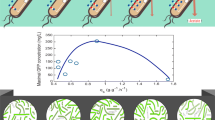Abstract
The influence of population heterogeneity and medium pH factors on the effect of α-acetolactate (AL) overproduction that we found in L. lactis bv. diacetylactis B2103/74 culture was studied. The nature of the enzymatic system responsible for this effect (which is able to considerably block lactate dehydrogenase (LDH) by intercepting up to 80% of the NADH in it) is unknown; we designated this system as the heminindependent electron transferring system (HEMIETS). It was demonstrated that manifestation of the effect was masked by the culture heterogeneity and was especially strong in approximately neutral pH values (6.1–6.5). The presence in the population of at least three types of dissociants differing in the level of HEMIETS activity, and consequently AL synthesis, was established: an active dissociant (AL accumulation up to 30 mM), an inactive dissociant that had lost the HEMIETS (AL no more than 3 mM), and a dissociant with intermediate activity (AL 15–17 mM). It was demonstrated that the HEMIETS activity at a particular pH value had primary importance in the emerging general picture of pyruvate metabolism at different pH values and, finally, in overproduction. Thus, no overproduction effect was observed at a pH of 7.0 due to the low HEMIETS activity, and the pyruvate metabolism passed according to homolactic type. However, the HEMIETS activity was so high at pH values of 5.3–6.5 that this allowed it to take the function of the main regulator of NAD+/NADH oxidation–reduction balance and to give a minor role to LDH. The LDH- and acetolactate synthase pathway productivity depended on the HEMIETS activity at a particular pH, while the productivity of pyruvate dehydrogenase pathway directly depended on the external pH. The latter was relatively high in approximately neutral area (pH 6.0–6.5) and was noticeably decreased in neutral (pH 7.0) and weakly acid (pH ≤ 6.0) zones.
Similar content being viewed by others
Abbreviations
- AD:
-
active dissociant
- AA:
-
amino acids
- AL:
-
α-acetolactate
- ALDC:
-
α-acetolactate decarboxylase
- ALS:
-
α-acetolactate synthase
- Ac:
-
acetoin
- HEMIETS:
-
heminindependent electron transferring system
- MSD:
-
metabolic shift depth
- Dc:
-
diacetyl
- YE:
-
yeast extract
- CL:
-
cultural liquid
- LDH:
-
lactate dehydrogenase
- LAB:
-
lactic acid bacteria
- ID:
-
inactive dissociant
- NOX:
-
NADH oxidase
- OD:
-
optical density
- DIA:
-
dissociant with intermediate activity
- PDH:
-
pyruvate dehydrogenase
- HD:
-
homolactic degree
References
Wainwright, T.D., Diacetyl—a review. Part I—Analytical and biochemical considerations, J. Inst. Brew., 1973, vol. 79, pp. 451–470.
Serebrennikov, V.M., Voronina, L.N., and Glazunov, A.V., Study of the synthesis of α-acetolactate, diacetyl precursor, by Lactococcus lactis batch culture, Biotekhnologiya, 2005, no. 3, pp. 13–21.
Serebrennikov, V.M., Kotova, L.N., and Glazunov, A.V., Biosynthesis of α-acetolactate in the natural mutant Lactococcus lactis ssp. lactis bv. diacetylactis V2103, devoid of α-acetolactate decarboxylase, depending of the medium composition, Biotekhnologiya, 2012, no. 3, pp. 20–31.
Serebrennikov, V.M., Kotova, L.N., and Glazunov, A.V., α-Acetolactate overexpression from glucose in the diacetyl producer Lactococcus lactis ssp. lactis bv. diacetylactis V2103, a natural mutant lacaking α-aacetolactate decarboxylase, Appl. Biochem. Microbiol., 2014, vol. 50, no. 7, pp. 24–38.
Condon, S., Responses of lactic acid bacteria to oxygen, FEMS Microbiol. Rev., 1987, vol. 46, pp. 269–280.
van Niel, E.W.J., Hofvendahl, K., and Hahn-Hagerdal, B., Appl. Environ. Microbiol., 2002, vol. 68, pp. 4350–4356.
Akimenko, V.K., Al’ternativnye oksidazy mikroorganizmov (Alternative Oxidases of Microorganisms), Moscow: Nauka, 1989.
Mil'ko, E.S. and Egorov, N.S., Geterogennost’ populyatsii bakterii i protsess dissotsiatsii (Heterogeneity of Bacterial Populations and Dissociation Process), Moscow: Izd. MGU, 1991.
Kempler, G.M. and Mckay, L.L., Improved medium for detection of citrate-fermenting Streptococcus lactis subsp. diacetylactis, Appl. Environ. Microbiol., 1980, vol. 39, pp. 926–927.
Rose, I.A., M. Grunberg-Manago, Korey, S.R., and Ochoa, S., Enzymatic phosphorylation of acetate, J. Biol. Chem., 1954, vol. 211, pp. 737–755.
Broome, M.C., Thomas, M.P., Hillier, A.I., and Jago, G.R., Pyruvate dehydrogenase activity in streptococci, Aust. J. Biol. Sci., 1980, vol. 33, pp. 15–25.
Snoep, J.L., Joost Teixeira de Mattos, M., Starrenburg, M.J.C., and Hugenholtz, J., Isolation, characterization, and physiological role of the pyruvate dehydrogenase complex and α-acetolactate synthase of Lactococcus lactis subsp. lactis bv. diacetylactis, J. Bacteriol., 1992, vol. 174, pp. 4838–4841.
Kisrieva, Yu.S., Serebrennikov, V.M., Zagustina, N.A., and Bezborodov, A.M., Isolation and purification of acetolactate synthase and acetolactate decarboxylase from the culture of Lactococcus lactis, Appl. Biochem. Microbiol., 2000, vol. 36, no. 2, pp. 109–114.
Novak, L. and Loubiere, P., The metabolic network of Lactococcus lactis: distribution of 14C-labeled substrate between catabolic and anabolic pathways, J. Bacteriol., 2000, vol. 182, pp. 1136–1143.
Cocaign-Bousquet, M., Garrigues, C., Loubiere, P., and Lindley, N.D., Physiology of pyruvate metabolism in Lactococcus lactis, Antonie van Leeuwenhoek, 1996, vol. 70, pp. 253–267.
Flambard, B., Helinck, S., Richard, J., and Juillard, V., The contribution of caseins to the amino acid supply for Lactococcus lactis depends on the type of cell envelope proteinase, Appl. Environ. Microbiol., 1998, vol. 64, pp. 1991–1996.
Juillard, V., le Bars, D., Kunji, E.R.S., Konings, W.N., Gripon, J., and Richard, J., Oligopeptides are the main source of nitrogen for Lactococcus lactis during growth in milk, Appl. Environ. Microbiol., 1995, vol. 61, pp. 3024–3030.
Benthin, S. and Villadsen, J., Amino acid utilization by Lactococcus lactis subsp. cremoris FD during growth on yeast extract or casein peptone, J. Appl. Bacteriol., 1996, vol. 80, pp. 65–72.
Drinan, D.F., Tobin, S., and Cogan, T.M., Citric acid metabolism in hetero-and homofermentative lactic acid bacteria, Appl. Environ. Microbiol., 1976, vol. 31, pp. 481–486.
Author information
Authors and Affiliations
Corresponding author
Additional information
Original Russian Text © L.N. Kotova, V.M. Serebrennikov, A.V. Glazunov, 2015, published in Biotekhnologiya, 2015, No. 4, pp. 28–38.
Rights and permissions
About this article
Cite this article
Kotova, L.N., Serebrennikov, V.M. & Glazunov, A.V. Role of population heterogeneity and pH factor in natural phenomenon of α-acetolactate overproduction in Lactococcus lactis ssp. lactis bv. diacetylactis B2103/74 diacetyl producer. Appl Biochem Microbiol 52, 750–759 (2016). https://doi.org/10.1134/S0003683816080056
Received:
Published:
Issue Date:
DOI: https://doi.org/10.1134/S0003683816080056




